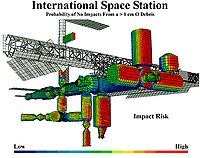
Photo from wikipedia
PurposeThe purpose of this study is to assess the heterogeneity of tumor enhancement using fractal analysis on contrast-enhanced computed tomography (CE-CT) for predicting malignant potential of gastrointestinal stromal tumor (GIST).MethodsWe… Click to show full abstract
PurposeThe purpose of this study is to assess the heterogeneity of tumor enhancement using fractal analysis on contrast-enhanced computed tomography (CE-CT) for predicting malignant potential of gastrointestinal stromal tumor (GIST).MethodsWe retrospectively identified 64 patients (36 M/28 W; median age: 65) with GISTs who received CE-CT and 18F-fluorodeoxyglucose positron emission tomography (FDG-PET) followed by curative surgery. Fractal analysis was applied to CE-CT image, and fractal dimension (FD) was measured. Diagnostic value of FD for malignant potential of GIST was compared with that of FDG-PET using the risk classification and Ki67 index.Results14 patients were categorized as the high risk, and 50 patients were as the very low, low or intermediate risk. FD of high-risk group was significantly higher than that of the other-risk group (p < 0.05). The areas under the ROC curves of FD and SUVmax for prediction of high-risk group were 0.82 and 0.93 (accuracy: 84.4% and 98.5%). FD showed a significant positive correlation with Ki67 index (p = 0.01).ConclusionDiagnostic value of CT fractal analysis for prediction of high-risk GIST is comparable with FDG-PET. In terms of cost and availability, fractal analysis has a potential to be an optimal preoperative biomarker.
Journal Title: Abdominal Radiology
Year Published: 2018
Link to full text (if available)
Share on Social Media: Sign Up to like & get
recommendations!